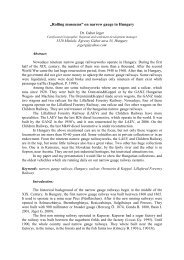'Representing Difficult Pasts within Complex Presents ... - T2M
'Representing Difficult Pasts within Complex Presents ... - T2M
'Representing Difficult Pasts within Complex Presents ... - T2M
Create successful ePaper yourself
Turn your PDF publications into a flip-book with our unique Google optimized e-Paper software.
sand-dunes and other difficult terrain (Pirie 2008) for their elite white owners. Under apartheid, access to<br />
driving motor vehicles was also racially segregated, as well as driving occupations (Horrell et al 1946-<br />
present). South Africa’s large urban, and often notorious, taxi industry arose as a result of forced<br />
removals as a result of the Group Areas Act (1950) during apartheid requiring people to travel greater<br />
distances, transport being now required beyond the feeder limits of bus services, which too benefited from<br />
forced removals (Khosa 1991). The impact of longer and more expensive travel distances to work, along<br />
with racial segregation imposed on public transport services, led to bus and train boycotts throughout<br />
Cape Town’s transport history (Pirie 2009, 2008, 1992, 1989, Sey 2008, Horrell et al 1946-present).<br />
6<br />
Likewise, ‘buffer’ zones were created through the construction of highways and railway lines in<br />
apartheid Cape Town, to separate white, black and coloured residential areas (See Sey 2008; Morris 1969;<br />
Watson 1998). Part of the argument for forced removals in Cape Town in the 1960s and 1970s was the<br />
need for highways to create a new city architecture that favoured white privilege (Morris 1969; Bank and<br />
Minkley 1999). Even access to train tickets under apartheid was controlled and restricted, in which<br />
special permission was required to obtain a ticket, for example, to work in Cape Town, as a means of<br />
monitoring and preventing the mobility of black South Africans (Horrell et al 1946-present). It is not<br />
surprising then, that transport in South Africa has been argued not as mobility, but as ‘immobility’ (Pirie<br />
2009); blockages, restrictions, barriers and boundaries not only in relation to physical mobility but which<br />
also even today continue, economically and socially, to have impact.<br />
In recent years, cities as a whole have been argued to be fluid creative spaces shaped through<br />
praxis, narrative and social imaginaries (Cinar and Bender 2007; Bridge and Watson 2004; Appadurai<br />
1991; Field 2007; Pile 2005; Taylor 1996; Biron 2009). Pile (2005) for example writes that the city does<br />
not only consist of a static urban infrastructure, but is infused with other meanings – myths, fantasies,<br />
desires, narratives, imaginaries, or what he terms ‘phantasmagorias’ – the more metaphorical, emotional,<br />
desires, fantasies and haunting sides of the city, in that ‘what is real about cities is the sheer<br />
expressiveness and passion of its life’ (1-2). Although Pile progresses to exploring vampire and ghost<br />
stories in the city, it is possible to extricate such an approach to transport histories in South Africa – what<br />
are the ‘ghosts’ of the past, the memories and associations, that haunt the present, through the presence of<br />
transport vehicles and a transport infrastructure? What are the ‘hidden’ problematic aspects of transport,<br />
the negative elements that, arguably, suck the life-blood out of the concept of a motile, mobile city of<br />
Cape Town?




